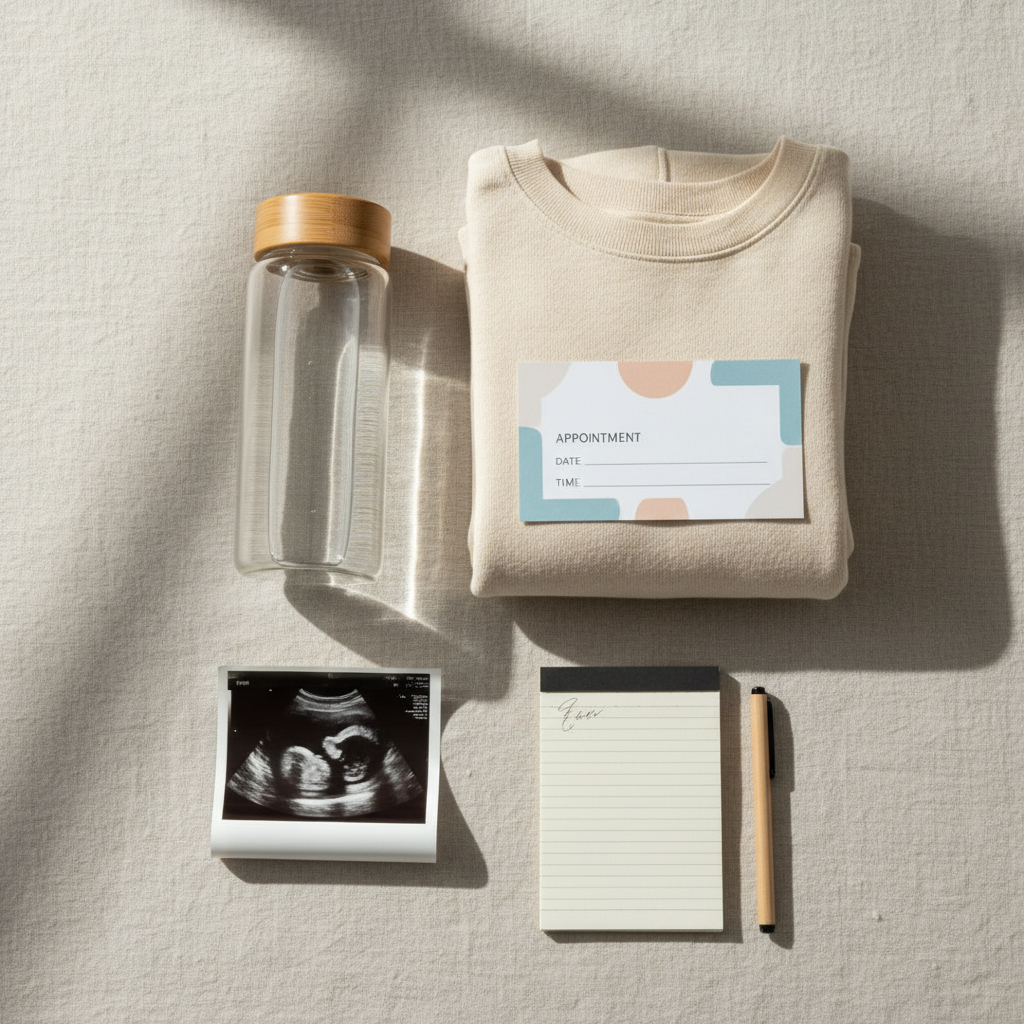
How Ultrasounds Help Track Baby’s Health
Ultrasounds provide a remarkable window into your baby’s development, allowing healthcare providers to monitor growth while giving you those first precious glimpses of your little one. During the second trimester, these imaging tools become especially valuable as your baby grows from a tiny embryo into a more recognizable little person with distinguishable features and measurable body parts.
Key Highlights
Here’s what makes ultrasound technology such an important part of prenatal care:
- Ultrasounds use sound waves to create images of your baby without any radiation exposure
- Different types of ultrasounds are used throughout pregnancy to monitor specific aspects of development
- The anatomy scan, typically performed around 20 weeks, provides a comprehensive view of your baby’s organs and structures
- Measurements taken during ultrasounds help track your baby’s growth pattern and overall health
- Both 2D and advanced 3D/4D ultrasounds serve important medical purposes while creating meaningful memories
Understanding Ultrasound Technology

Ultrasound imaging uses high-frequency sound waves to create real-time pictures of your baby inside the womb. The transducer device sends sound waves through your abdomen that bounce off your baby’s tissues and return to create an image on a screen. Unlike X-rays, ultrasounds don’t use radiation, making them safe for both mother and baby throughout pregnancy. The technology has been used for decades in prenatal care and continues to advance, offering clearer images and more detailed information with each passing year.
Several types of ultrasound technologies serve different purposes during your pregnancy journey. The standard 2D ultrasound provides black-and-white images showing your baby’s outline and internal structures. Doppler ultrasounds focus on blood flow patterns, which help assess circulation in the placenta and baby’s heart. For those experiencing pregnancy headaches second trimester discomfort or other complications, specialized ultrasounds like transvaginal scans might be recommended to get a closer look at the cervix or lower uterine structures. Advanced options like 3D ultrasounds create more lifelike images of facial features, while 4D ultrasounds add the dimension of movement, allowing you to see your baby’s actions in real time.
Your Ultrasound Timeline
During pregnancy, ultrasounds are performed at strategic points to assess different aspects of your baby’s development. Your first ultrasound typically occurs in the first trimester, around 6-8 weeks, to confirm pregnancy, establish a due date, and check for a heartbeat. This early scan may be transvaginal rather than abdominal to get a clearer view of the tiny embryo. Some healthcare providers also conduct a nuchal translucency scan between 11-14 weeks to screen for certain chromosomal conditions.
The highlight of the ultrasound schedule often comes during the 2nd trimester with the comprehensive anatomy scan. Scheduled between 18-22 weeks, this detailed examination checks all major organs and structures, measures growth, and can often determine your baby’s sex if desired. The anatomy scan takes longer than other ultrasounds, typically 30-45 minutes, as the technician carefully examines and documents your baby’s development. Additional scans in the third trimester may be recommended to monitor growth, check placenta position, or assess amniotic fluid levels. Each ultrasound provides valuable information about your baby’s progress while allowing you to witness their development firsthand.
What Your First Trimester Ultrasound Reveals

The first ultrasound marks an emotional milestone as you see your baby for the first time, though what you’ll see depends on how far along you are. In early pregnancy, your baby appears as a small blob with a flickering heartbeat—a powerful moment for many parents despite the simple image. This initial scan confirms your pregnancy is developing in the uterus (not ectopic), determines the gestational age by measuring the crown-rump length, confirms the number of babies, and detects the heartbeat. According to the American College of Obstetricians and Gynecologists, hearing that heartbeat reduces the risk of miscarriage to less than 5%.
As you approach the end of your first trimester, your baby becomes more recognizable with a distinct head and the beginning of limb development. Around 11-14 weeks, some providers offer a nuchal translucency screening, which measures fluid behind the baby’s neck to screen for chromosomal conditions. This ultrasound may also evaluate the nasal bone and other markers that provide information about your baby’s development. By week 13, as you enter the second trimester, your baby’s profile becomes more distinct, with visible arms, legs, and sometimes even movement, though you likely won’t feel these movements for several more weeks.
The Comprehensive Second Trimester Anatomy Scan
The anatomy scan, typically performed between 18-22 weeks, is the most detailed ultrasound you’ll experience during pregnancy. During this 30-45 minute examination, the sonographer takes extensive measurements and captures images of all major organs and body parts. Your baby’s brain, heart, lungs, kidneys, spine, and limbs are carefully examined for proper development. The heart, in particular, receives special attention with views of its four chambers and blood flow patterns. The sonographer also measures the head circumference, abdominal circumference, and femur length to assess growth compared to gestational age norms.
Beyond examining your baby, this comprehensive scan also evaluates the placenta’s position, the amniotic fluid level, and the length of your cervix. The placenta’s location is important because a low-lying placenta or placenta previa may require additional monitoring or affect delivery plans. While most parents look forward to learning their baby’s sex during this scan, remember that the primary purpose is medical assessment rather than gender reveal. The detailed information gathered during the anatomy scan helps identify any potential concerns early, allowing your healthcare team to develop appropriate care plans if needed. The 2nd month pregnancy feelings of uncertainty often give way to excitement during this scan as your baby’s features become clearly visible and their health can be more thoroughly assessed.
How Ultrasounds Track Your Baby’s Growth

Healthcare providers use specific measurements from ultrasounds to track your baby’s growth throughout pregnancy. The three primary measurements—head circumference, abdominal circumference, and femur length—help create a comprehensive picture of how your baby is developing. These measurements are plotted on growth charts and compared to standardized percentiles for gestational age. Your baby doesn’t need to be exactly at the 50th percentile; what matters most is consistent growth along their established curve. A sudden change in growth pattern might prompt additional monitoring, but variations between babies are entirely normal.
The estimated fetal weight calculation combines these measurements to approximate how much your baby weighs. While not perfectly accurate (estimates can be off by as much as 10-15%), this information helps track overall growth trends. Beyond size, ultrasounds monitor developmental milestones appropriate to gestational age. For example, during the second trimester, your baby should be showing regular movement, practicing breathing motions, and developing more defined features. If growth appears slower or faster than expected, your provider may recommend more frequent ultrasounds to ensure your baby continues to develop appropriately and to investigate potential causes for growth variations.
When Additional Ultrasound Monitoring Is Needed
Sometimes circumstances warrant more frequent or specialized ultrasound monitoring beyond the standard schedule. High-risk conditions such as gestational diabetes, high blood pressure, or a history of pregnancy complications often require additional growth scans to ensure your baby continues developing well. If your baby appears smaller or larger than expected for gestational age, your healthcare provider may recommend biweekly or monthly ultrasounds to track growth more closely. These extra checks provide valuable information while helping manage any anxiety you might feel about your baby’s health.
Specialized ultrasound technologies serve important roles in monitoring specific concerns. Doppler ultrasounds assess blood flow through the umbilical cord and placenta, especially important in cases of growth restriction or placental issues. Fetal echocardiography provides detailed images of the heart when structural concerns are suspected. Cervical length ultrasounds help monitor for signs of preterm labor risk. While the need for additional monitoring might feel concerning, these tools provide your healthcare team with crucial information to optimize your care. Many parents find that these extra ultrasounds, while sometimes prompted by concerns, offer additional opportunities to connect with their baby visually while ensuring they receive the most appropriate prenatal care.
Preparing for Your Ultrasound Experience
Making the most of your ultrasound appointments starts with simple preparation. For abdominal ultrasounds, you’ll typically be asked to arrive with a full bladder, which helps push the uterus up and provides clearer images, especially in early pregnancy. Wear comfortable, two-piece clothing that allows easy access to your abdomen while maintaining privacy. Some imaging centers suggest avoiding lotion on your belly on the day of your appointment, as it can interfere with the transmission of sound waves. Consider bringing your partner or support person to share in the experience, as most facilities allow at least one guest during routine ultrasounds.
Preparing thoughtful questions beforehand helps you get the most information from your appointment. Ask about your baby’s growth percentiles, the structures being examined, and what the images show about your baby’s development. While most ultrasounds reveal normal, healthy development, understand that sonographers often cannot give immediate interpretations of findings; a radiologist or your healthcare provider will review the images and discuss any concerns. Some facilities offer printed images or video recordings for a fee, while others have options to email digital images. These keepsakes become treasured mementos of your pregnancy journey and your baby’s earliest moments. Remember that ultrasound experiences vary widely between 8 weeks and 38 weeks, with your baby changing dramatically from a tiny bean-shaped embryo to a fully-formed infant ready for birth.
Beyond the Images: The Emotional Impact of Ultrasounds
Ultrasound appointments represent more than medical check-ups—they’re often profound bonding experiences for expecting parents. Seeing your baby’s movements, facial features, and even behaviors like thumb-sucking creates a powerful connection long before birth. Research has shown that these visual encounters can enhance parental-fetal bonding and make the pregnancy feel more real, especially for partners who aren’t physically experiencing the pregnancy. Many parents describe their baby’s first ultrasound as the moment that transformed their pregnancy from an abstract concept to the reality of a new family member.
While ultrasounds primarily serve medical purposes, it’s perfectly normal to experience a range of emotions during these appointments. Joy, awe, relief, and sometimes even anxiety may surface as you witness your baby’s development. If you’re feeling nervous before an ultrasound, communicate with your healthcare provider about your concerns. Most are happy to explain what they’re looking for and what the images show. Consider starting a pregnancy journal where you record your thoughts and feelings after each ultrasound, perhaps including the printed images alongside your reflections. These appointments provide valuable medical information while creating meaningful memories that many parents cherish long after their baby has arrived.
Conclusion
Ultrasounds offer that perfect balance of medical monitoring and emotional connection throughout your pregnancy journey. From confirming those first heartbeats to detailed anatomy assessments and growth tracking, these remarkable imaging tools help ensure your baby’s development stays on the right path. While each pregnancy follows its own timeline, ultrasounds provide reassurance and valuable information at every stage.
As you continue through your pregnancy, embrace each ultrasound appointment as both a health check and a special opportunity to meet your baby before birth. These glimpses into your baby’s world help build the foundation for the lifelong relationship that awaits, while giving your healthcare team the information they need to support you both every step of the way.
